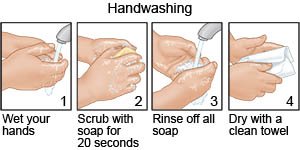Peritoneal Dialysis Catheter Care
Medically reviewed by Drugs.com. Last updated on Apr 6, 2025.
What is peritoneal dialysis catheter care?
Peritoneal dialysis catheter care is instruction on how to help keep the catheter working properly and to prevent infection. You will need to care for the catheter site by cleaning it and changing your bandages correctly. Your healthcare provider will change your bandages for the first 2 weeks. When your exit site is healed, you may need to change your bandages every day. Your dialysis team will teach you how to care for the area where the catheter goes into your skin. The following information can help remind you of steps to take for catheter care. Let your team know if you have any questions or problems.
How do I get ready for catheter care?
- Gather your supplies:
- Medical gloves and a medical mask
- Bandages and medical tape
- Chlorhexidine or other solution as directed by your healthcare provider
- Clean towel or new paper towels
- Wash your hands with soap and water. Scrub them for at least 15 seconds. Dry your hands well with a clean towel or new paper towel. Your healthcare provider may also recommend that you use an alcohol-based hand gel after you dry your hands. The gel will help kill any bacteria that remain after you wash your hands.

- Put on your mask, and then your gloves. Make sure the mask covers both your nose and your mouth. This will help prevent germs from your nose or mouth reaching the exit site. Put on your gloves. Do not touch anything other than the bandage and your supplies when your gloves are on.
How should I do catheter care?
- Change your bandages. Your dialysis team will change your bandages for the first 2 weeks. When your exit site is healed, you may need to change your bandages every day. Pour the solution over bandages that are stuck on your exit site to loosen them. If there is a scab, do not pull on it. Remove the bandages slowly. Do not move, pull, or twist the catheter when you change your bandages. Make sure the catheter stays in place.
- Clean the skin around the catheter site. Wipe your skin gently. Use chlorhexidine or the solution your healthcare provider recommends. Pat the area dry with a clean towel. Your provider may tell you to apply an antibiotic lotion or cream to the site to prevent a bacterial infection.
- Cover the catheter and the exit site with a bandage. Cover the catheter when you are not using it to help it stay in place. This may help stop the catheter from bending and kinking, or being pulled out. Use several layers of bandages to cover the exit site and the skin around the catheter. Hold the bandages in place with tape.
What can I do to prevent infection?
- Wash your hands often. Use soap and running water, or an alcohol-based hand gel. Wash your hands often during the day. Always wash before and after catheter care.
- Keep the catheter in place. Ask your healthcare provider how to tape the catheter to your body. This may help prevent it from twisting and being moved or pulled out.
- Look for signs of infection. Signs include swelling, redness, or pus. Check for infection every time you change your bandages.
- Keep the catheter site dry. Do not take a bath or put the exit site under water. Leave the bandages on until after you shower. Then put on new bandages.
- Take antibiotic medicine as directed. This helps prevent or treat an infection caused by bacteria.
When should I call my doctor?
- The catheter has come part or all of the way out of your abdomen.
- The catheter has a crack or hole in it.
- The exit site is red, swollen, or has pus.
- Fluid is leaking from the exit site.
- You have stomach pain or are vomiting.
- You see or feel a new lump on your abdomen.
- You have a fever.
- Your legs and feet are swollen.
- You have questions or concerns about your condition or care.
Care Agreement
You have the right to help plan your care. Learn about your health condition and how it may be treated. Discuss treatment options with your healthcare providers to decide what care you want to receive. You always have the right to refuse treatment. The above information is an educational aid only. It is not intended as medical advice for individual conditions or treatments. Talk to your doctor, nurse or pharmacist before following any medical regimen to see if it is safe and effective for you.© Copyright Merative 2025 Information is for End User's use only and may not be sold, redistributed or otherwise used for commercial purposes.
Learn more about Peritoneal Dialysis Catheter Care
Treatment options
Further information
Always consult your healthcare provider to ensure the information displayed on this page applies to your personal circumstances.
